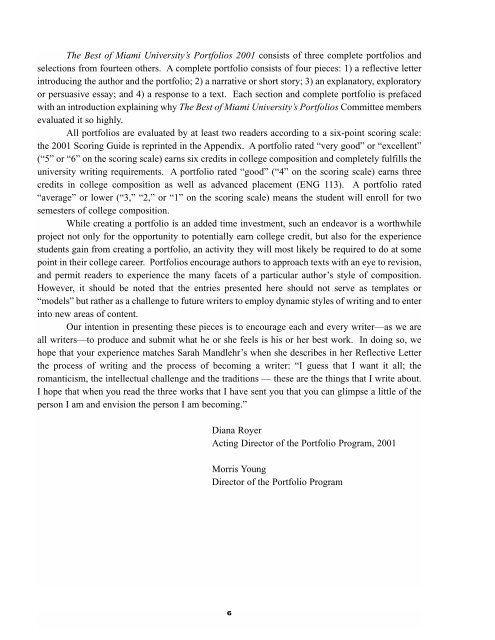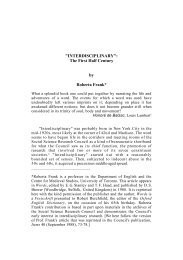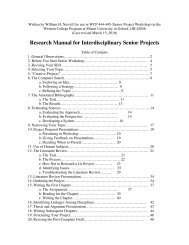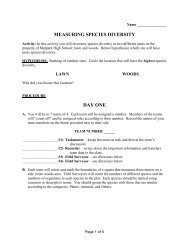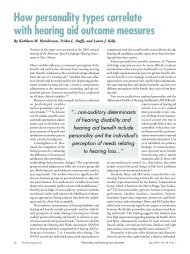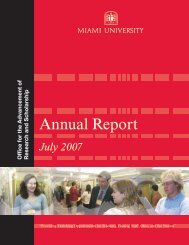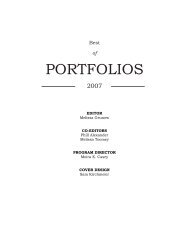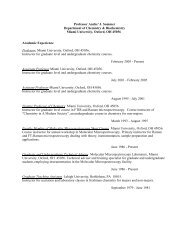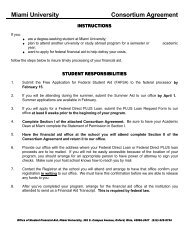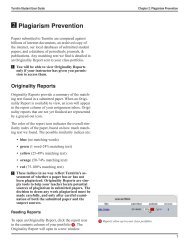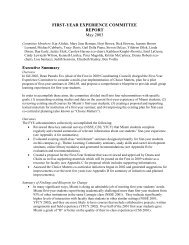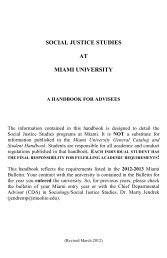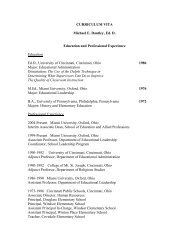Best of Miami Portfolios 2001 - Units.muohio.edu
Best of Miami Portfolios 2001 - Units.muohio.edu
Best of Miami Portfolios 2001 - Units.muohio.edu
You also want an ePaper? Increase the reach of your titles
YUMPU automatically turns print PDFs into web optimized ePapers that Google loves.
The <strong>Best</strong> <strong>of</strong> <strong>Miami</strong> University’s <strong>Portfolios</strong> <strong>2001</strong> consists <strong>of</strong> three complete portfolios and<br />
selections from fourteen others. A complete portfolio consists <strong>of</strong> four pieces: 1) a reflective letter<br />
introducing the author and the portfolio; 2) a narrative or short story; 3) an explanatory, exploratory<br />
or persuasive essay; and 4) a response to a text. Each section and complete portfolio is prefaced<br />
with an introduction explaining why The <strong>Best</strong> <strong>of</strong> <strong>Miami</strong> University’s <strong>Portfolios</strong> Committee members<br />
evaluated it so highly.<br />
All portfolios are evaluated by at least two readers according to a six-point scoring scale:<br />
the <strong>2001</strong> Scoring Guide is reprinted in the Appendix. A portfolio rated “very good” or “excellent”<br />
(“5” or “6” on the scoring scale) earns six credits in college composition and completely fulfills the<br />
university writing requirements. A portfolio rated “good” (“4” on the scoring scale) earns three<br />
credits in college composition as well as advanced placement (ENG 113). A portfolio rated<br />
“average” or lower (“3,” “2,” or “1” on the scoring scale) means the student will enroll for two<br />
semesters <strong>of</strong> college composition.<br />
While creating a portfolio is an added time investment, such an endeavor is a worthwhile<br />
project not only for the opportunity to potentially earn college credit, but also for the experience<br />
students gain from creating a portfolio, an activity they will most likely be required to do at some<br />
point in their college career. <strong>Portfolios</strong> encourage authors to approach texts with an eye to revision,<br />
and permit readers to experience the many facets <strong>of</strong> a particular author’s style <strong>of</strong> composition.<br />
However, it should be noted that the entries presented here should not serve as templates or<br />
“models” but rather as a challenge to future writers to employ dynamic styles <strong>of</strong> writing and to enter<br />
into new areas <strong>of</strong> content.<br />
Our intention in presenting these pieces is to encourage each and every writer—as we are<br />
all writers—to produce and submit what he or she feels is his or her best work. In doing so, we<br />
hope that your experience matches Sarah Mandlehr’s when she describes in her Reflective Letter<br />
the process <strong>of</strong> writing and the process <strong>of</strong> becoming a writer: “I guess that I want it all; the<br />
romanticism, the intellectual challenge and the traditions — these are the things that I write about.<br />
I hope that when you read the three works that I have sent you that you can glimpse a little <strong>of</strong> the<br />
person I am and envision the person I am becoming.”<br />
Diana Royer<br />
Acting Director <strong>of</strong> the Portfolio Program, <strong>2001</strong><br />
Morris Young<br />
Director <strong>of</strong> the Portfolio Program<br />
6


